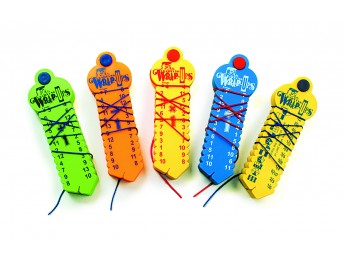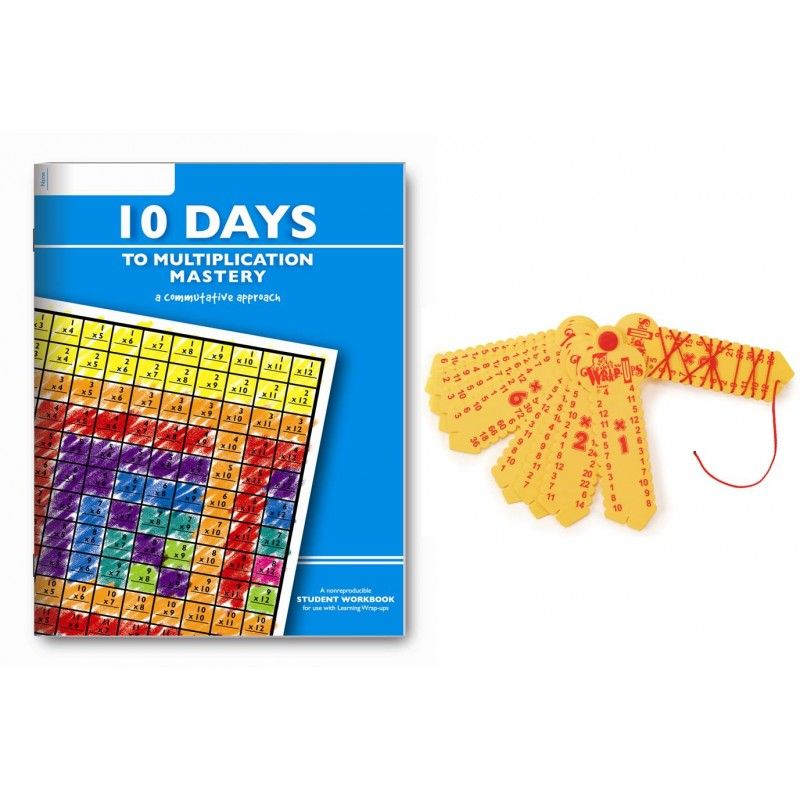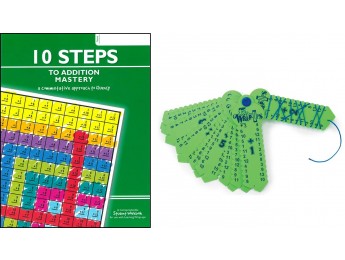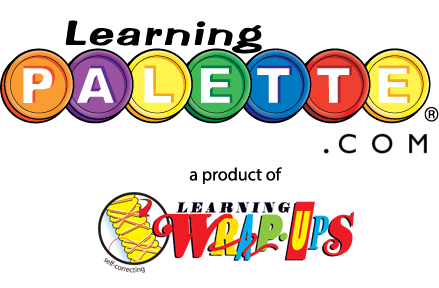
We were so very lucky to get to review so many wonderful products from Learning Wrap-Ups. We received:
- 2nd Grade Math Learning Palette 1 Base Center Kit
- 2nd Grade Reading 1 Base Center Kit
- Learning Wrap-up Basic Math Intro Kit
- Learning Wrap-up Vocabulary Intro Kit
- 10 Days to Multiplication Mastery Wrap-up and Book Combo
- 10 Steps to Addition Mastery Wrap-up and Book Combo
- LearningPalette.com
WHAT IS IT?:
Learning Wrap-ups offers a variety of math learning products for children in grades K-5th, as well as a variety of reading learning products for children in grades K-3rd.

The 2nd Grade Math Learning Palette 1 Base Center Kit contained one base with 6 card packs that covered adding & subtracting 2-digit numbers, understanding 3-digit numbers, money, fractions, and simple multiplication and division, algebra concepts, geometry & measurement, and probability & statistics. Each card pack contained 12 cards with 12 questions each. The whole set contains a total of 864 questions! This is available for $71.99.

The 2nd Grade Reading 1 Base Center Kit contains 5 card packs that cover vocabulary, capitalization & punctuation, reading comprehension, grammar, and word usage. Each card pack contains 12 cards with 12 questions each. The whole set contains a total of 720 questions! This is available for $61.99.

The Learning Wrap-up Basic Math Intro Kit includes wrap-ups for multiplication, division, addition, subtraction, and fractions. It’s available for $44.99. There is an expanded version of this set that also comes with a set of audio CD’s and a teaching guide. That one is available for $59.99. Some of the other Crew members received that one, so check out their reviews for feedback on that version.

The Learning Wrap-up Vocabulary Intro Kit include 4 sets of wrap-ups that cover synonyms, antonyms, homonyms, and compound words. This set is available for $35.99.

The 10 Days to Multiplication Mastery Wrap-up Combo includes a multiplication wrap-up and a 62-page student workbook to help your child master their multiplication facts in just 10 days! This is available for $12.99. If you already own the multiplication wrap-up or plan to get it in the Basic Math Intro Kit, then you can purchase just the student workbook for only $4.99.
 The 10 Steps to Addition Mastery Wrap-up and Book Combo includes an addition wrap-up and a 62-page student workbook to help your child master their addition facts in just 10 days! This is available or $12.99. As with the multiplication kit, if you need just the student workbook, it’s only $4.99.
The 10 Steps to Addition Mastery Wrap-up and Book Combo includes an addition wrap-up and a 62-page student workbook to help your child master their addition facts in just 10 days! This is available or $12.99. As with the multiplication kit, if you need just the student workbook, it’s only $4.99.
The LearningPalette.com includes online access to all levels of both math and reading learning palettes for a set price based on the number of students subscribed:
levels of both math and reading learning palettes for a set price based on the number of students subscribed:
- 1 student for $25
- 2-5 students for $60
- 6-15 students for $165
The price grid continues from there for classroom use, but I’ve included the prices that would meet the needs of homeschool families.
The vendor is offering a SPECIAL DISCOUNT for homeschool families through May 31, 2015! Just enter the coupon code “HomeSchool” when placing your subscription order at LearningPalette.com.
OUR EXPERIENCE:
We received so many wonderful products to try out that I tried to rotate around with what we were using so that the kids hopefully wouldn’t get tired of using the same things too many times in a 
My plans for Holden, age 6, were to have him work on the 2nd grade Learning Palette products, the 10 Steps to Addition Mastery set, try out the subtraction wrap-up from the Basic Math set, and to play a bit with the online program. My plans for Haylee, age 9, were to have her mainly work on the Online Learning Palette subscription, the 10 Days to Multiplication Mastery set, and to play with the division wrap-up in the Basic Math set.
Learning Palettes
I have to say that as soon as Holden started working with the physical Learning Palettes, Haylee was a bit jealous. Despite their draw to computer-based games, my kids always like hands-on 
We started by selecting a card and placing it on the little pegs on the base, and then we lined up the colored discs in pairs (one solid and one with a hole in the center for each color) along the side for easy access. Then Holden set out to answer the questions. I usually sat with him to help him match up the questions with the right discs, at least until he got the hang of it, and just to offer support and help him stay focused. My kids have attention issues, so while these activities can easily be done independently once the student knows how they work, it’s always a good idea for me to stick around to help keep my kids on task. Once Holden had placed all the discs on the tray, we simply had to flip over the card to see the self-correcting answers on the back. Each problem is written out with the correct answer, but he could quickly see how he’d done by the color-coded answers indicated around the perimeter of the card as he looked to see if they matched with how he’d laid out his discs on the tray.
We alternated between using the math and the reading cards to keep it fresh, and he seemed to enjoy them each time we pulled them out. He just finished 1st grade math and reading in our homeschool, so this was relatively new material, and we stuck with the beginner cards in each pack during the review period. But with so many questions in each set, these will easily last us throughout our school year.
I really like how the cards are indexed on the back of each pack so you can quickly find the specific skills you wish to have your child practice. We’re just beginning our new school year (we school year-round), so it will continue to be a real benefit for me to be able to pull out a corresponding card for him to use for practice alongside his math and reading programs for school. I can see that it will be a fun way to help break up the monotony of our regular math and reading assignments and reinforce those skills for him.
Online Learning Palette Subscription
Haylee was the main user of the online program, but I did have Holden try it out a few times. It didn’t keep his interest as well as the physical palettes, though, and I think that’s due to his age.
Haylee really wanted to be able to use the program on her tablet for portability. I tried pulling it up on her android tablet using her browser, but it didn’t seem to work very well on there. I tried it on my iPad, but it didn’t function properly on that operating system, either. The vendor doesn’t advertise that it can be used on tablets, so that wasn’t a problem. But if I could make a suggestion to the vendor, it would be to make an app so subscribers could successfully use the program on tablets, since they are so popular with kids these days. I think it would be a big selling point for getting my kids to use it. But for now, we just had to stick with using it on the computer only.
First of all, I just w
The online program works by showing the palette in the middle of the screen and the colored
In using the program, we found that sometimes when one of the kids would complete a card on the website, it would not show that the card had been completed, even though it showed all green check marks to indicate the questions were answered correctly when they completed the card. The kids found that a bit frustrating, so sometimes I had to offer to re-do the card for them to see if I could get it to give them credit for having completed it. After playing with it for a while, I found that it didn’t function as well in my Google Chrome browser as it did in Internet Explorer, so once I made that realization, I started always setting it up for my kids to use in IE.
Overall, I would say the kids liked the online version, but it does seem to have a number of glitches that need to be worked out, and it didn’t have the same draw for my kids for repeated use that the physical palettes had. It’s something I had to tell them to do, as opposed to them pulling it up on their own to play for fun.
Learning Wrap-Ups
With the math learning wrap-ups, you select a plastic card that indicates which numeral you’re working with for that function, and then you bring the string up from the back and start on the left with the number you’re pairing with that main numeral, and then wrap the string across the front to the answer on the right-hand side and take the string to the back once again. You continue this wrapping around the card until all of the problems have been completed. Then you turn the card over and match up your string placement with the lines drawn on the back of the card. In this way, it’s quick and easy to self-correct your work. The vocabulary cards work the same way, matching words together from left to right for things like synonyms, antonyms, homonyms, and compound words.
Coordination of holding the card stack, which is joined together with a pin so that you have to rotate one away by itself to work on it, and then wrapping the string around and around can take some getting used to. It was a much harder for Holden than for Haylee, as his fine motor skills are not as advanced as hers. Haylee initially had some difficulty with getting the string tangled as she worked, but she overcame that with practice. But this is a great, portable tool for practicing math facts and language arts skills. Holden was a bit happier having me do the wrapping while he told me the answers. With his age, I don’t have a problem giving him a hand with the physical use of them until he further develops his fine motor skills. The activities they contain are still great practice.
You can purchase the “mastery” products in a couple of different ways. You can either buy the combo packs with the workbooks and the corresponding wrap-ups, or you can buy the Basic Math Intro Kit that I received and then buy the mastery workbooks separately. The wrap-ups you need for the mastery programs are included in the basic set of wrap-ups. However you choose to obtain the materials you need, this is a worthwhile program to have.

The workbook for 10 Days to Multiplication Mastery is set up by daily activities that take the child through one set of facts at a time. There’s a combination of repeated drills on the learni
The workbook for 10 Steps to Addition Mastery was set up similarly to the multiplication book. Holden had pretty good recall of his addition facts already, but this was good reinforcement for him, too. However, as I mentioned earlier, he doesn’t have the coordination yet to hold the wrap-up and keep the string tight enough to do it properly, so he struggled with the physical aspect of the wrap-ups. Someone had to help him each time he wrapped it around to keep the string tight so it would stay in place and not start slipping
Overall, I think these are wonderful products that would certainly complement any homeschool math or language arts curriculum you might be using for your elementary students.
Check out what other Crew members thought of these products from Learning Wrap-ups by clicking the link below.


Very thorough review. Thank you! I am very interested in this product so seeing what those who reviewed it thought...
ReplyDeleteThanks for stopping by and for the feedback! I really think the Palettes were the neatest part, but the wrap-ups are nice for older kids...they're just a bit too much for little ones in a physical sense. They were great for my 9, almost 10-year old, though. I saw the states and capitals wrap-up at my local homeschool bookstore and picked it up for her since we just finished a 50-state study. They do have some neat selections in those! http://learningwrapups.com/homeschool/home-school-wrap-ups/geography-wrap-ups/states-and-capitals-wrap-up-keys.html
ReplyDelete